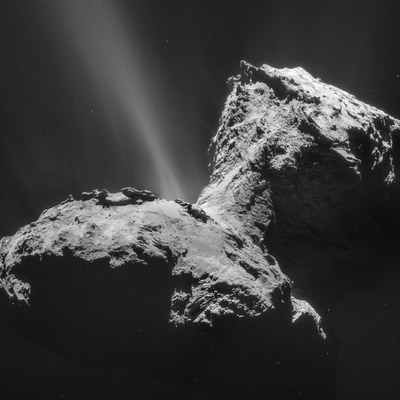Rosetta: Europe's comet chaser
The international Rosetta mission was a cornerstone mission in ESA's Horizons 2000 Science Program. The spacecraft was launched from Kourou, French Guiana, in March 2004 on an Ariane 5 rocket. Rosetta's 10-year journey through the solar system included several fly-by maneuvers around Earth, Mars, asteroids Steins and Lutetia. A long electrical hybernation phase was required to ensure survival of the spacecraft subsystems at distances larger than 3 AU from the Sun. In August 2014, Rosetta arrived at its final target, comet 67P/Churyumov-Gerasimenko (67P/CG). Rosetta remained in close-proximity to the comet nucleus as it approached perihelion and the comet became active with a dense comma.
Rosetta completed a historic mission, being the first spacecraft ever to orbit a cometary nucleus and the first to accompany a comet on its path towards the inner Solar System. It observed the icy and dusty surface of this new world from very close distance, dispatching a robotic lander (Philae) that would eventually touchdown after bouncing off the smooth terrain on the smaller lobe of the nucleus. In September 2016, Rosetta ended its mission after a controlled hard-landing on the comet surface.
The Rosetta mission is over, but the scientific interpretation of the data delivered by its 12 on-board instruments continues. Comets are remnants of the early days of our Solar System. Their pristine reservoirs of ice and organic compounds are believed have deliverd the source material for the formation of planetesimals. The study of the origin and evolution of comets is key to understand the formation of larger bodies and the origin of life on Earth. The evolutionary connection between organic rich comets and other volatile depleted bodies, like the asteroids, remains an active field of research.
The Radio Science Investigations (RSI)
The Radio-Science Investigations (RSI) experiment aboard Rosetta (M. Pätzold et al., 2007) is leaded by Principal Investigator (PI) Dr. M. Pätzold at Universität zu Köln, and by Co-Investigators (Co-I) Prof. Dr. Bernd Häusler and Dr. Tom Andert at Universität der Bundeswehr (UniBw).
The RSI experiment exploits the radio propagation properties of the unmodulated carrier signal of Rosetta's Telemetry, Tracking and Command (TT&C) subsystem. An ultra-stable oscillator (USO) connected to both X-band (8.4 GHz) and S-band (2.3 GHz) spacecraft transponders was required for phase-stable one-way downlink observations. Microwave propagation effects including frequency and phase variations, depolarization, spectral dispersion, and attenuation along the radio path were studied to resolve for geophysical properties of the target bodies and electrical properties of the interaction media (e.g. the cometary surface and the solar corona).
Science Objectives
Asteroid Lutetia
The mass of the asteroid Lutetia could be determined from radio-tracking observations during the flybys in 2010. (T.P. Andert, 2010)
Investigations of the Comet Interior and the Cometary Coma

Determination of the cometary mass and bulk density was a primary objective for RSI due to its fundamental value to assess the validity and accuracy of comet formation models. The two-way Doppler frequency-shift observables on the Earth-to-Spacecraft radio link as Rosetta orbited in close vicinity to the comet were used for this purpose (M. Pätzold et al., 2016). Radio-observables in combination with optical landmarks are being further studied to refine the knowledge of the gravity coefficients and moments of inertia of the comet nucleus.
Throughout its perihelion pass, an increased activity was observed at the nucleus. A mixture of dust and ice is ejected from the surface as the solar irradiance increases, creating a cometary tail or coma. The volatile content of the ejected mixture could be observed by other Rosetta instruments during this phase, where several unexpected organic compouds were detected. The refractive content of the mixture is believed to redeposit on the surface as activity ceases. An estimation of the mass-loss of comet 67P/CG during its 2014 perihelion was derived from radio-tracking data by RSI (M. Pätzold et al., 2018). The effect of mass redistribution on the moments of inertia and its spin rotation is a current subject of study.
Non-gravitational forces (e.g., gas and dust emissions) from the comet shape the trajectory of the nuclues around the Sun. Radio-tracking of Rosetta, in combination with relative observables of the comet from the spacecraft (e.g. optical images), are being explored to constrain the magnitude and variability of these forces, as well as to provide an improved ephemerides of the comet.
Surfaces of the Comet Nucleus
In 2014, a bistatic-radar experiment was performed by RSI to measure the scattering properties of the nucleus, and hence constrain the effective dielectric constant and material properties of the shallow surface (T. Andert, 2015). During each of the six surface observation tracks, the high-gain antenna aboard Rosetta illuminated the surface at predicted specular reflecting regions. The signal power echoed from the surface in opposite-sense circular polarizations was measured on Earth at one of NASA's Deep Space Network (DSN) 70-meter antenna facility. A precise calibration procedure was required to enable a valid comparison of the polarization channels.
For an electrically smooth surface, the effective dielectric constant of the surface material mixture can be inferred from the ratio of power scattered in opposite-sense circular polarizations. The interpretation of the RSI bistatic radar observations is a current area of research.
Solar corona investigation
Radar probing of the solar corona allows direct measurements of the inner solar wind. RSI secondary objectives included the radio sounding of the solar corona during the superior conjunctions of the spacecraft with the Sun during the cruise phase.
Project Framework
| Funded by: | German Aerospace Centre (DLR) |
| Cooperation: | Universität zu Köln, University of Stanford, University of the French Polynesia, NASA/JPL, Max-Planck Institute for Solar System Research |
| Duration: | 2004 - 2020 |

